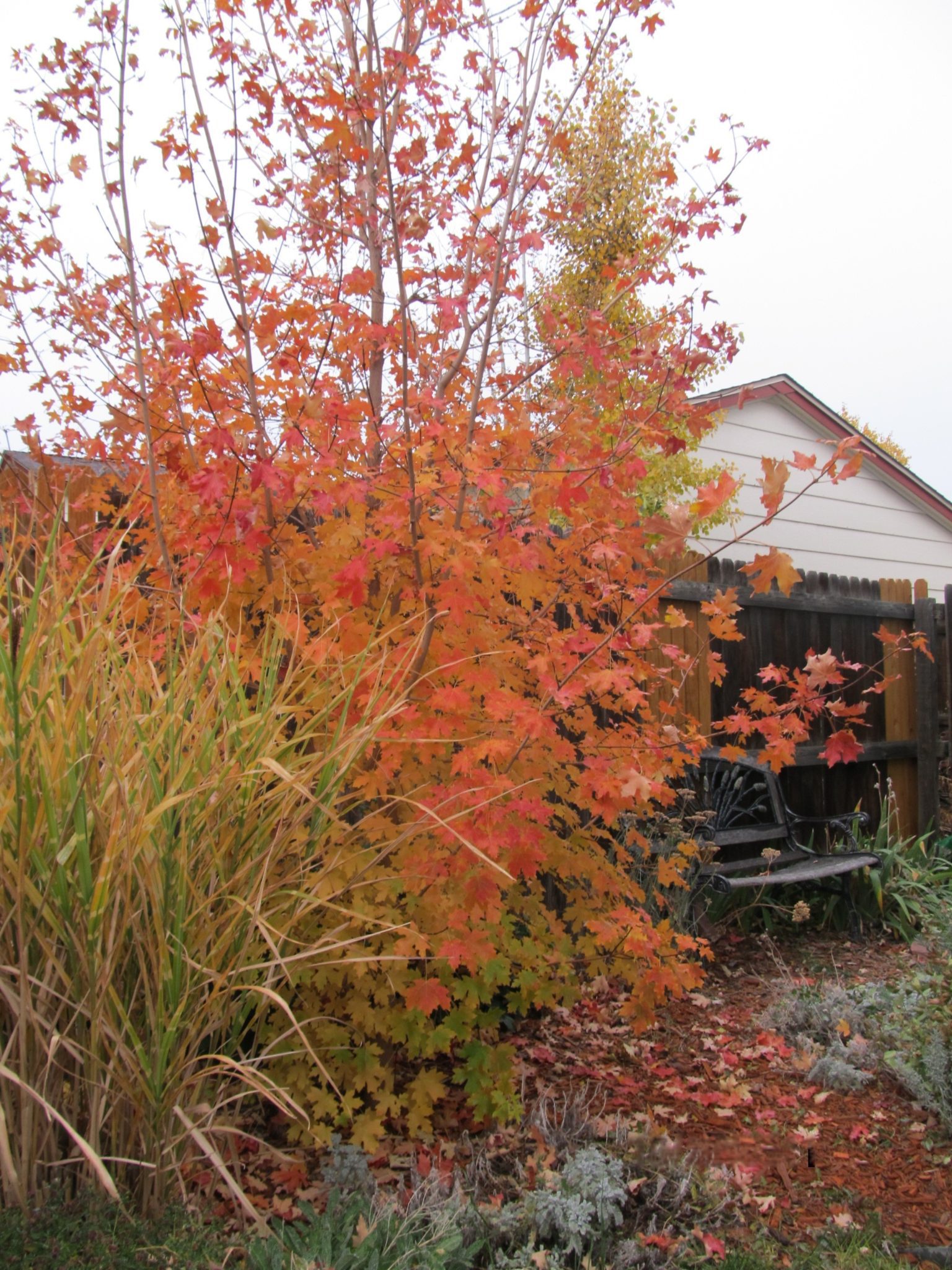
In the fall of 2019 I was going to write a post about the importance of selecting trees and shrubs for autumn foliage. The point of the post I was going to write was that in spite of what you may have heard or read, there is nothing absolutely nothing wrong with selecting trees and shrubs for their autumnal color.
Over the years I have read numerous articles that have baldly stated that you should NEVER select trees and shrubs bases solely their potential fall display. The reason being that there are far too many variables beyond the gardener’s control that can greatly affect the quality of the autumn display. A wet and cool summer can delay the change in leaf color by a week or more, whereas a hot and dry summer can cause the change to start weeks earlier than normal.
Cloudy autumn days and how cold the autumn nights get can also change how intense the colors get.
And, of course, a severe storm can roll through can strip the trees bare before they have reached their peak colors.
The only thing that actually is in the gardener’s control is to select trees and shrubs that are genetically hardwired for good fall color, and to plant them in a spot where the conditions are the most conducive for producing said color (i.e. in a sheltered spot that gets plenty of sun).
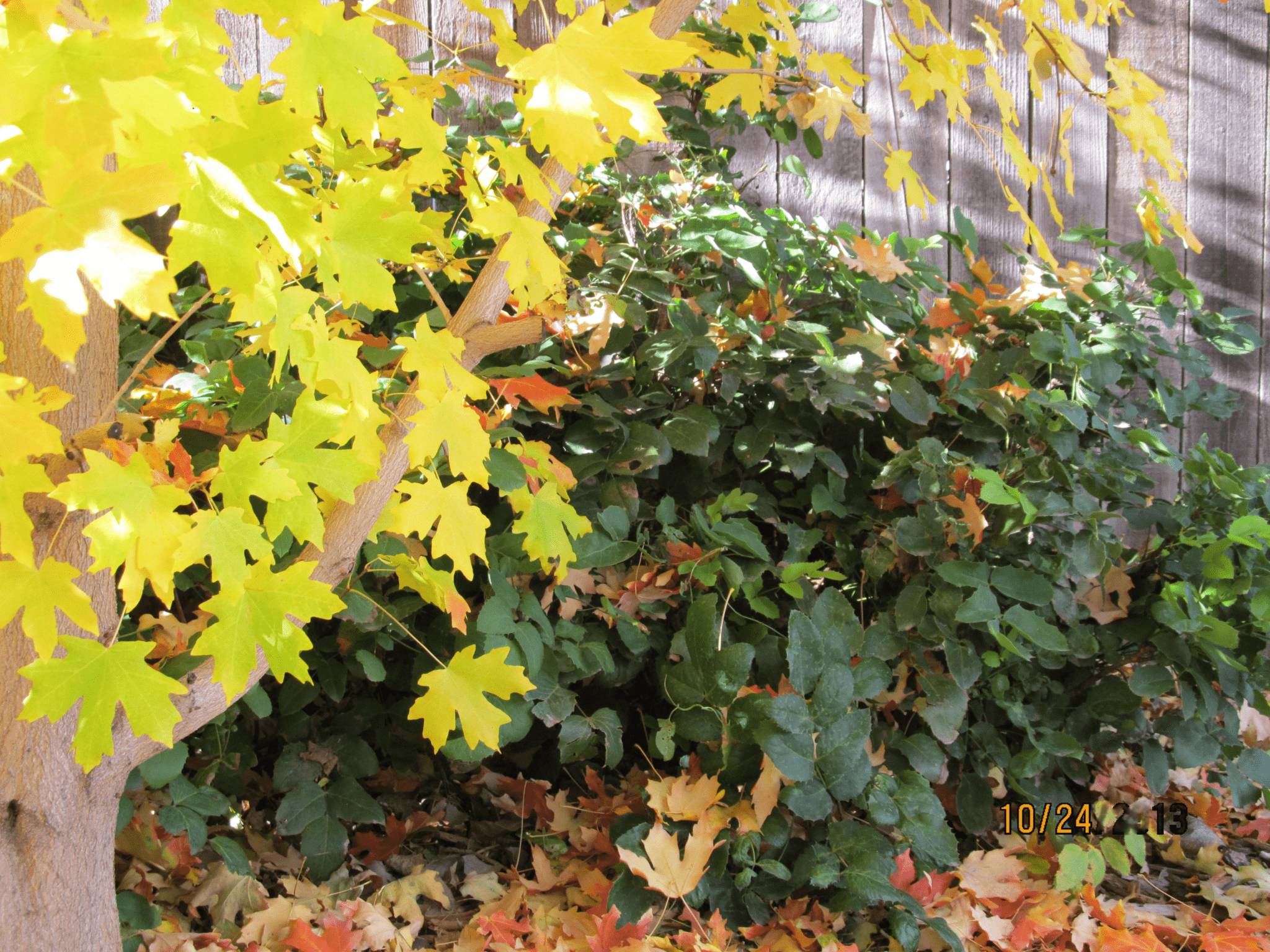
Rubbish!, said I
I was going to make the argument that such concerns are pure poppycock. After all, spring weather can lay waste to many spring flowers in an instant, but I have never read an article recommending not planting something like a lilac bush, as an example, just because a spring cold snap might destroy its blooms.
I used a lilac bush as an example on purpose. It blooms for about a week and then it is finished for the year. While it’s an reasonably attractive shrub during much of the growing season, when it is not in bloom it turns a proverbial wallflower. It does not have two or more seasons of interest: no berries in the summer, no fall colors in autumn, no architectural interest in winter. So if a spring snowstorm zaps the spring flower display, the show is over.
Oops…
Unfortunately for me, the weather during the autumn of 2019 kind of proved that the conventional wisdom was right. Here in Colorado the month of September was warmer than average, and the heat lingered well into October. Finally, in mid-October, the temperatures fell to more seasonal levels. The trees and shrubs were just beginning to display their autumn finery.
Then disaster struck: an arctic cold front blasted through the eastern part of the state, dropping temperatures down to almost single digits overnight. By the next day the leaves on the trees turned brown and started falling off. Within a couple of days most of the trees and shrubs along the Front Range were completely denuded of their leaves. The show was cancelled for the year
I stand by my contention (with a few provisos)
Ok, so it turns out that there are indeed potential downsides to picking large woody plants based solely on their autumn foliage. Still, I stand by my contention that there is nothing wrong with choosing plants for fall color, just as long as these plants offer multi-seasons of interest.
The term “multi-seasons of interest” refers to a plant that has attributes that make it stand out in two or more seasons. For example, chokeberry trees (aronia) produce a profusion of white flowers in spring, followed by red or black berries in late summer, and then finish out the growing season with an intense autumnal display.
So, when choosing large plants such as trees and shrubs, I still say that it’s alright to pick them based on their autumn display as long as they have other qualities that meet your landscaping needs.
For good autumn color, pay attention to your conditions
I live in a USDA zone 5 (Help | USDA Hardiness Zones) high prairie garden, one that receives less than 18 inches of moisture a year. My soil is also very clayey and leans to the alkaline side of the PH scale. Which means I need to be very selective about which trees and shrubs I plant in my yard. I once had an Amur Maple that is supposed to thrive in Colorado, but succumbed to chlorosis (lack of iron) because my soil is so alkaline it couldn’t readily access the iron in the soil.
Trees and shrubs that grow in in the West all tend to have yellow fall color. Apparently, this is a reaction to the alkaline soils that are so prevalent out here. So finding trees that produce good red or orange fall colors is a bit of a challenge. But they are available.
One further point: when shopping for trees and shrubs for thier autumn color, I would wait until the plants are starting to turn. For one thing, this will give you an idea of the quality of the their fall finery. Plus, nurseries and big-box stores usually put their inventory on sale in late summer and early fall, saving you a great deal of money (the downside of waiting is that the selection may be a bit picked over).
Finally, early autumn is the best time of the year to plant trees and shrubs. The air is cool, yet the soil is still warm. These conditions help reduce transplant shock, and allow the plants to establish roots before the really cold weather arrives.
What works in my landscape
So let’s see what plants provide good fall color in my landscape.
First up, I have two Honeylocust trees in my yard, one in the front and one in the back. While these Honeylocusts certainly don’t have multi-seasons of interest, they do provide plenty of dappled shade, the kind of shade that allows plants underneath them to thrive while still providing relief from the sun for the over-heated gardener. This alone makes them worthy trees.
Honeylocusts are relatively drought tolerant with few pest or disease problems I recommend selecting the thornless variety, as the thorns on Honeylocusts can be quite nasty. If you want to cut down on autumn clean-up, I suggest the seedpod-less varieties as well.
Both honeylocusts turn bright yellow in autumn.
Next up in my Eastern Redbud. This tree is a North American native, and even though it hails from the eastern portion of the continent, it is surprisingly drought tolerant. Its golden-yellow foliage tends to appear a little earlier in the season than the honeylocust.
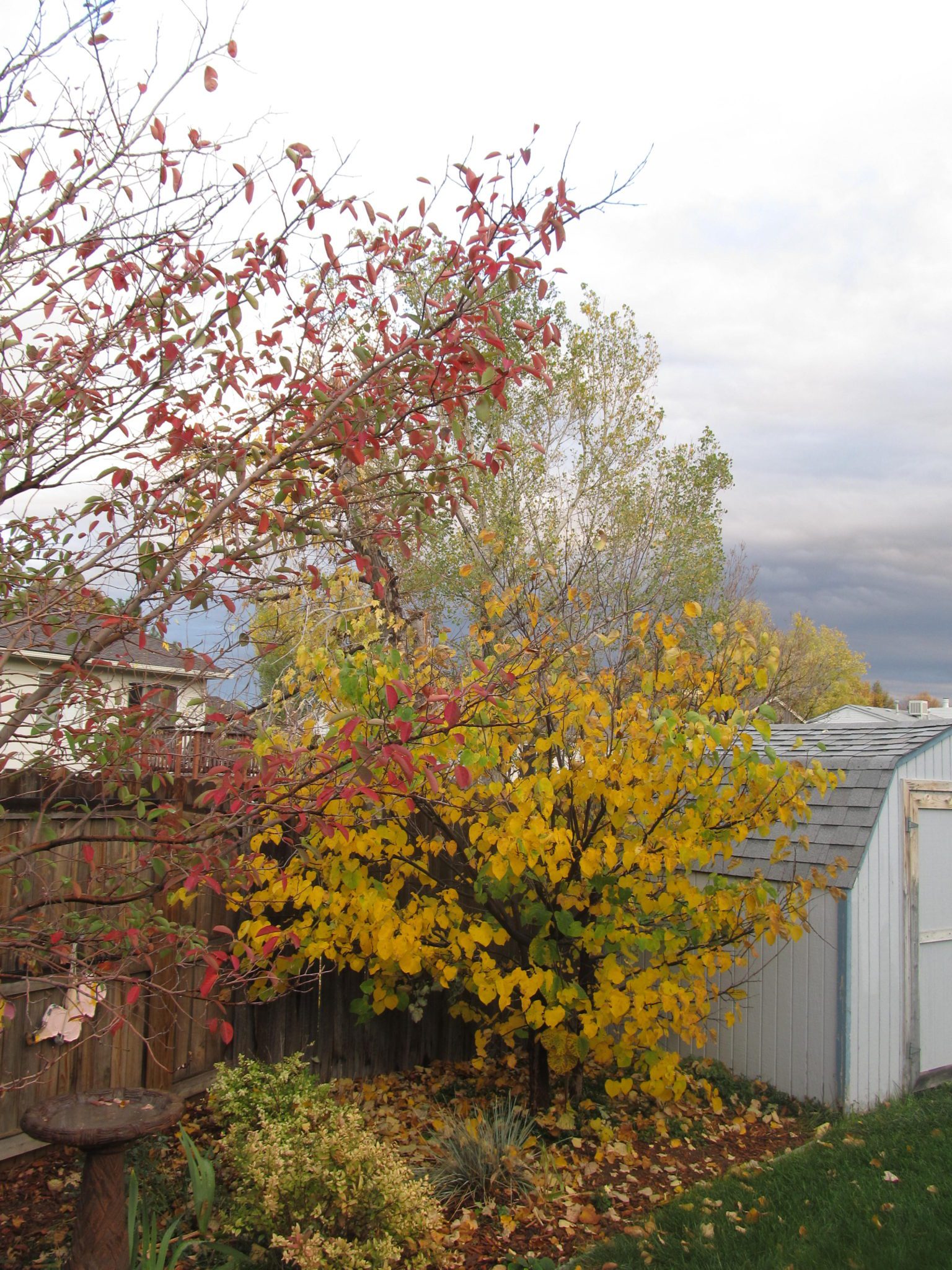
My next autumn performer is this ‘Standing Ovation’ serviceberry. This has only been in my landscape for a couple of years, so it is still just pup. This variety of serviceberry grows 12-15 feet tall but only 4 feet wide. It too turns yellow in the fall.
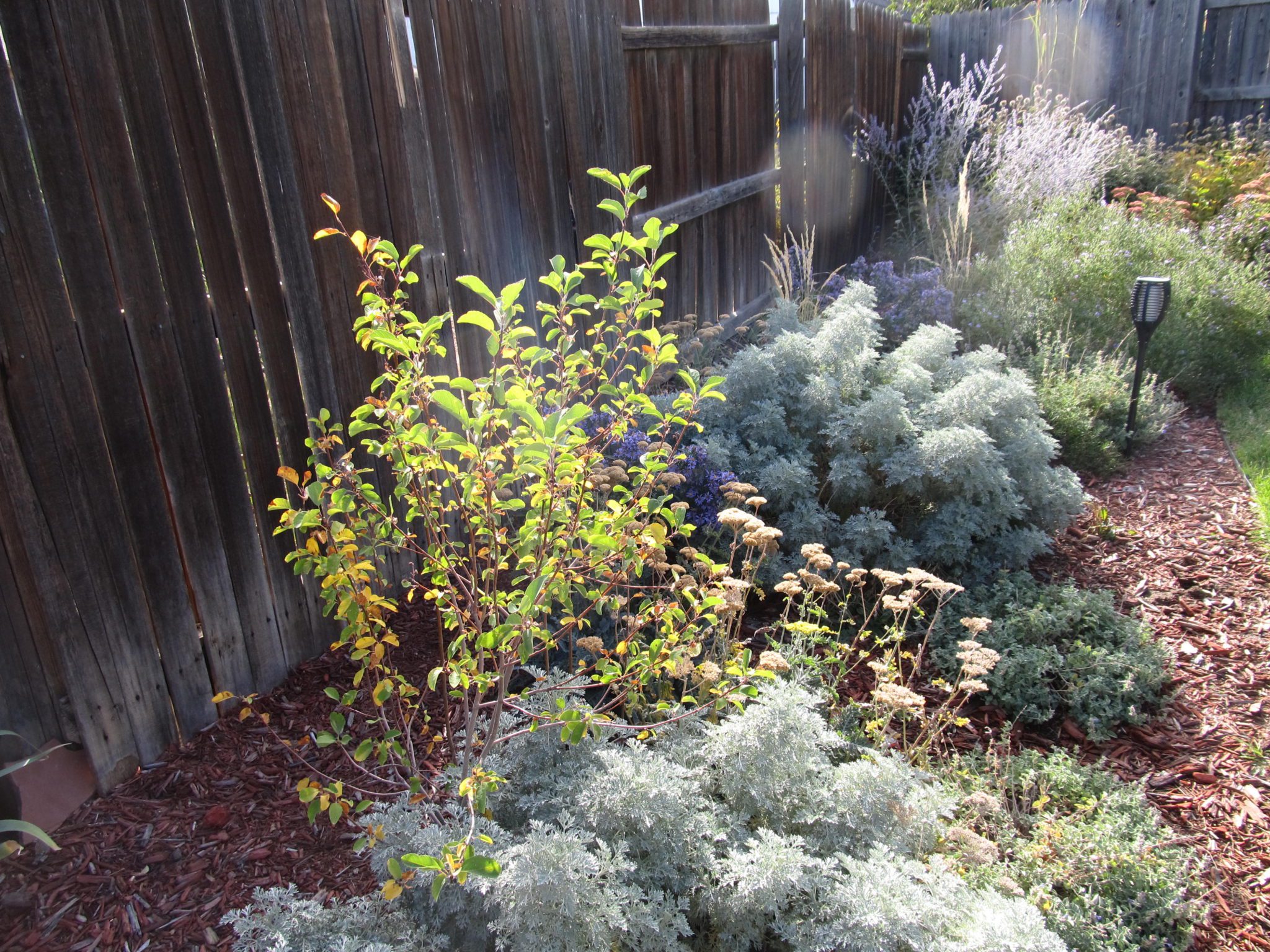
Now to the reds and oranges.
I have two native Bigtooth maples in my yards, also one in the front and one in the back. I think these Big-tooth Maples (acer Granditatum) are my favorite large woody plants. While their flowers are insignificant, they provide year-round architectural interest and the one in the back provides shade for the patio.
Bigtooth maples are a good understory tree, and only get to about 15-25 feet tall. As you can see, their leaves transform into an intense orange color in autumn.
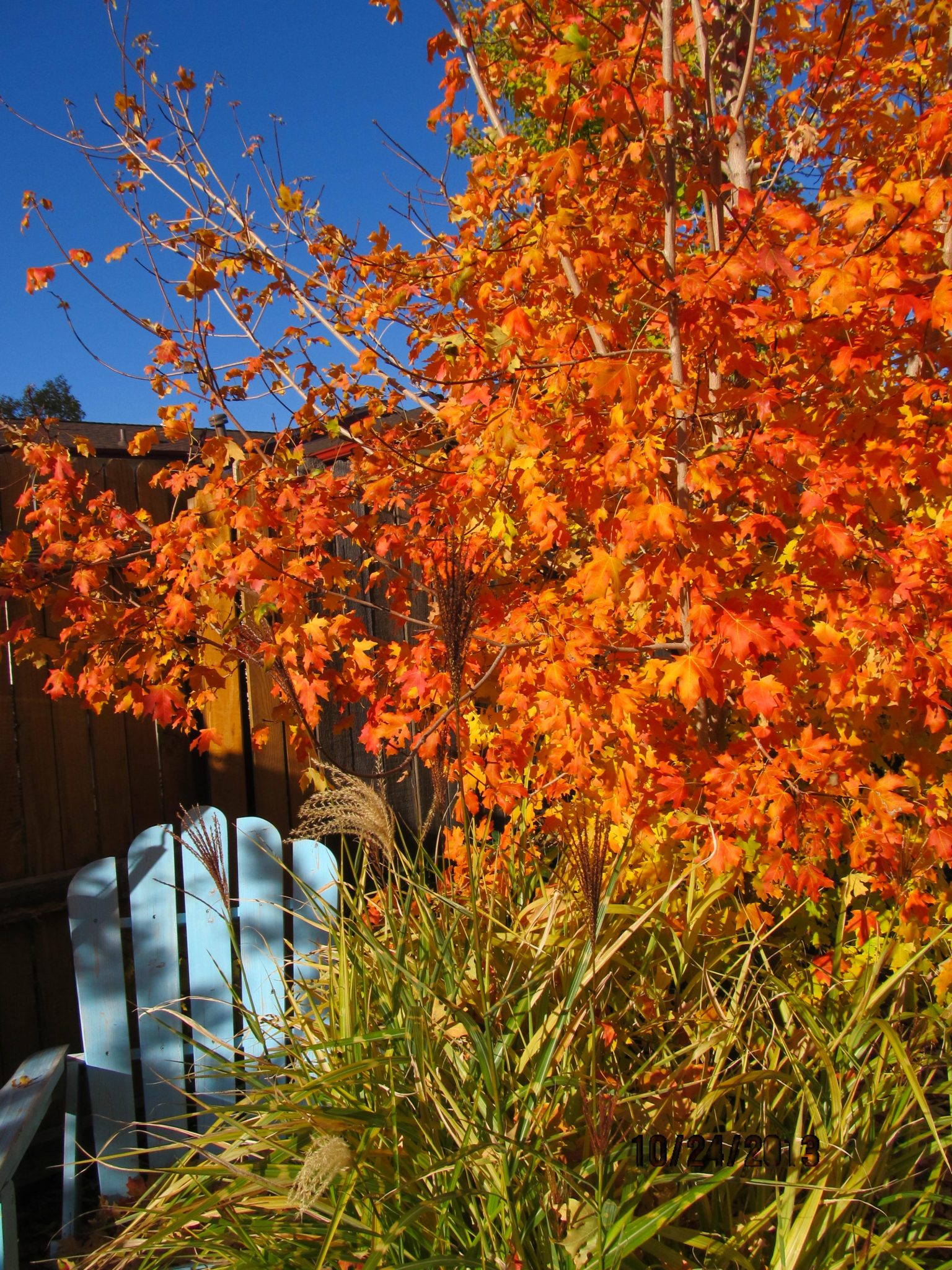
This next shrub is called Peking Cotoneaster, and I’ll admit I’m a little conflicted about it. As you can see, it too produces good orange autumn color. Unfortunately, that’s about all it does. It’s flowers are inconspicuous, and while it does set dark blue berries in early fall, the birds consume them so fast that I rarely ever see them.
It also has no architectural interest. In fact, it’s more of a tangled mess, which you can see in the picture below this one. It can reach 10-12 feet tall and wide. I cut back and moved this one to it current location a few years ago because it outgrew its old location. I suppose I could just chop it back to the ground in the spring to keep it in check, but the fact it only is interesting for a week or two in the fall is making me ponder replacing it.
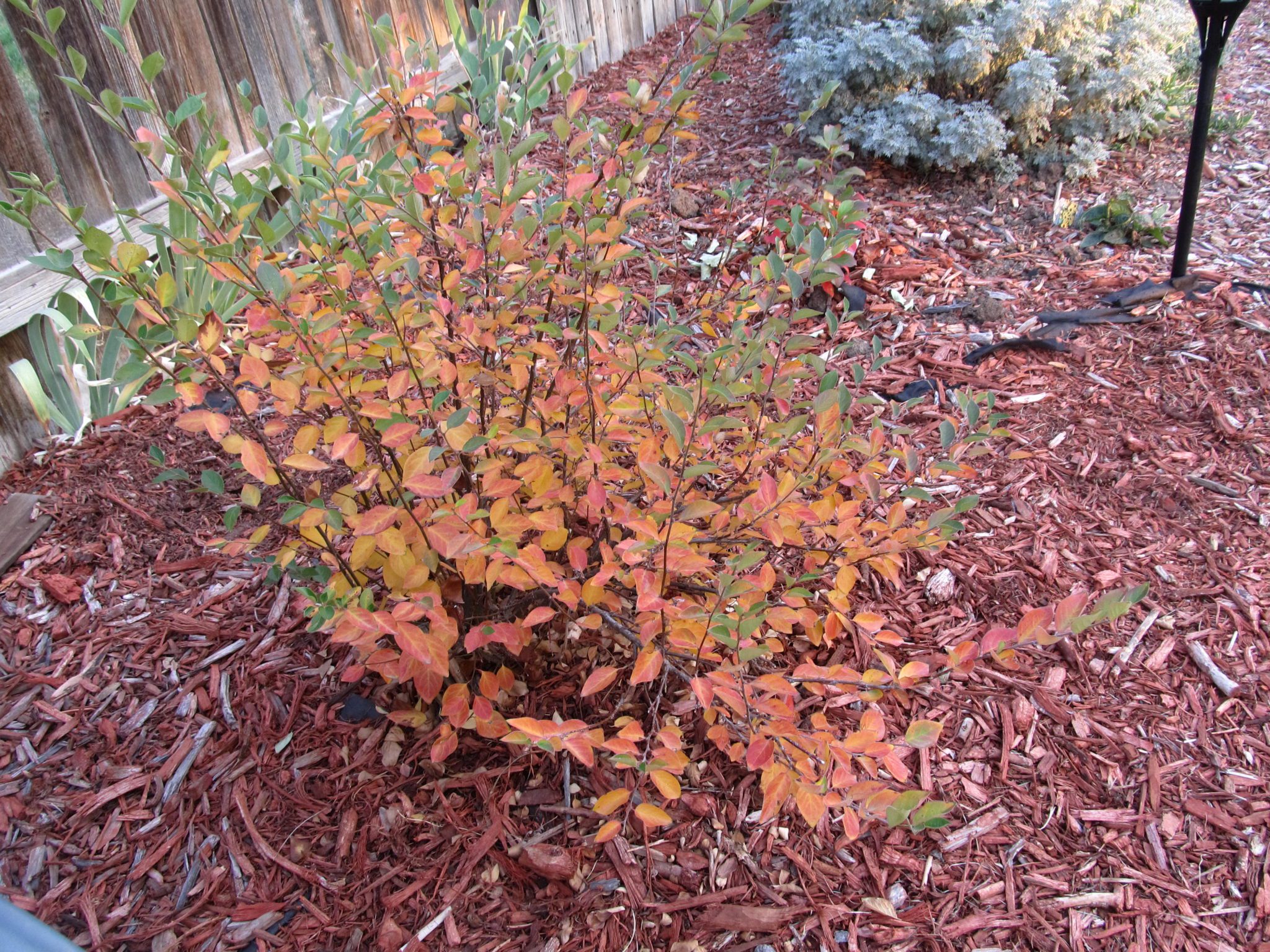
Below is what this cotoneaster looks like when fully mature. For a couple of weeks out of the year, it truly is glorious!
(If you look on the right side of the picture, about halfway down, you can see a few remaining berries that the birds somehow missed).
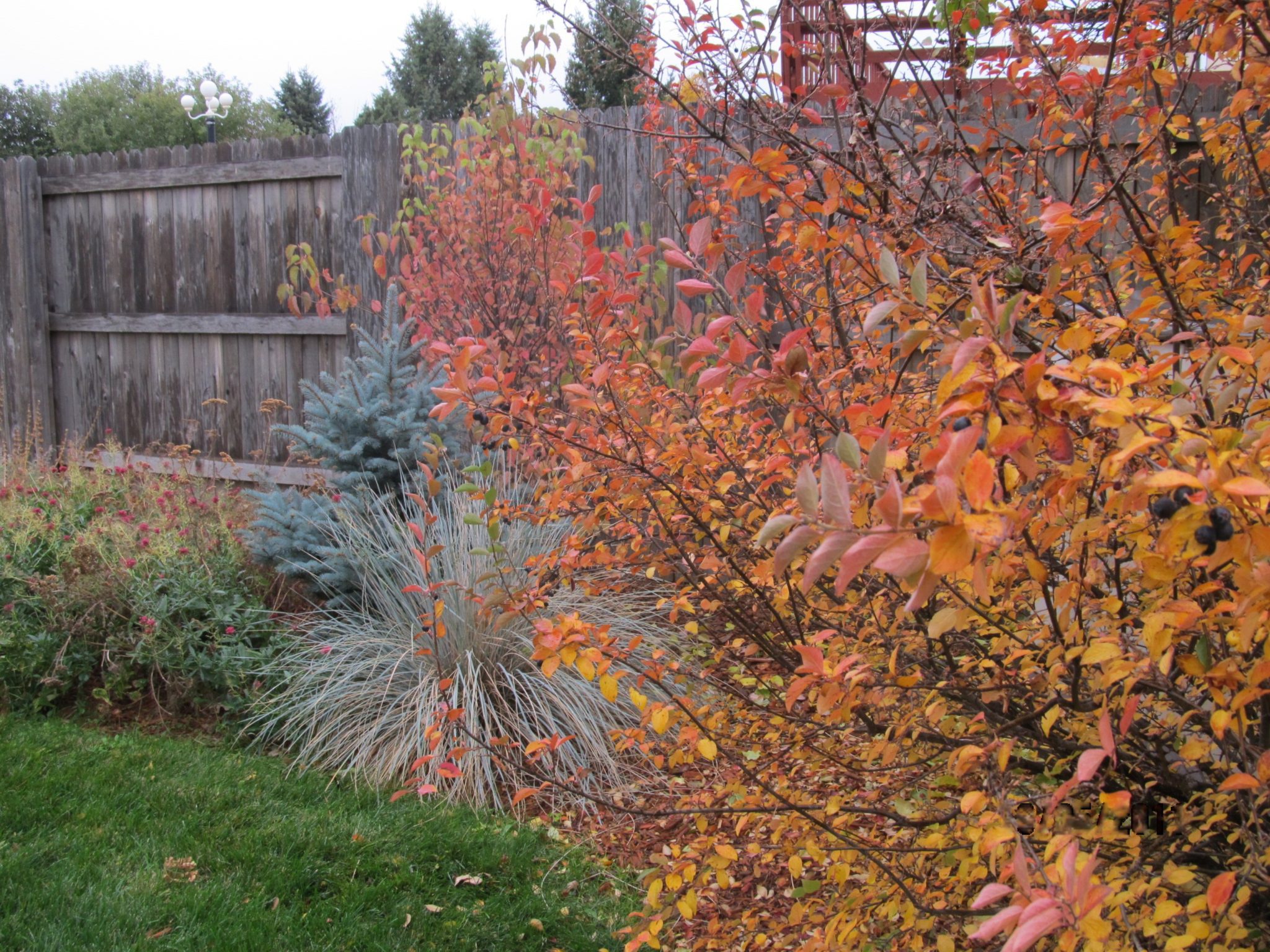
I planted this black chokeberry (aronia ‘Low Scape Mound’) last summer, so it too is just a youngling. But even in its first year in my garden it was already showcasing its bright red autumn finery.
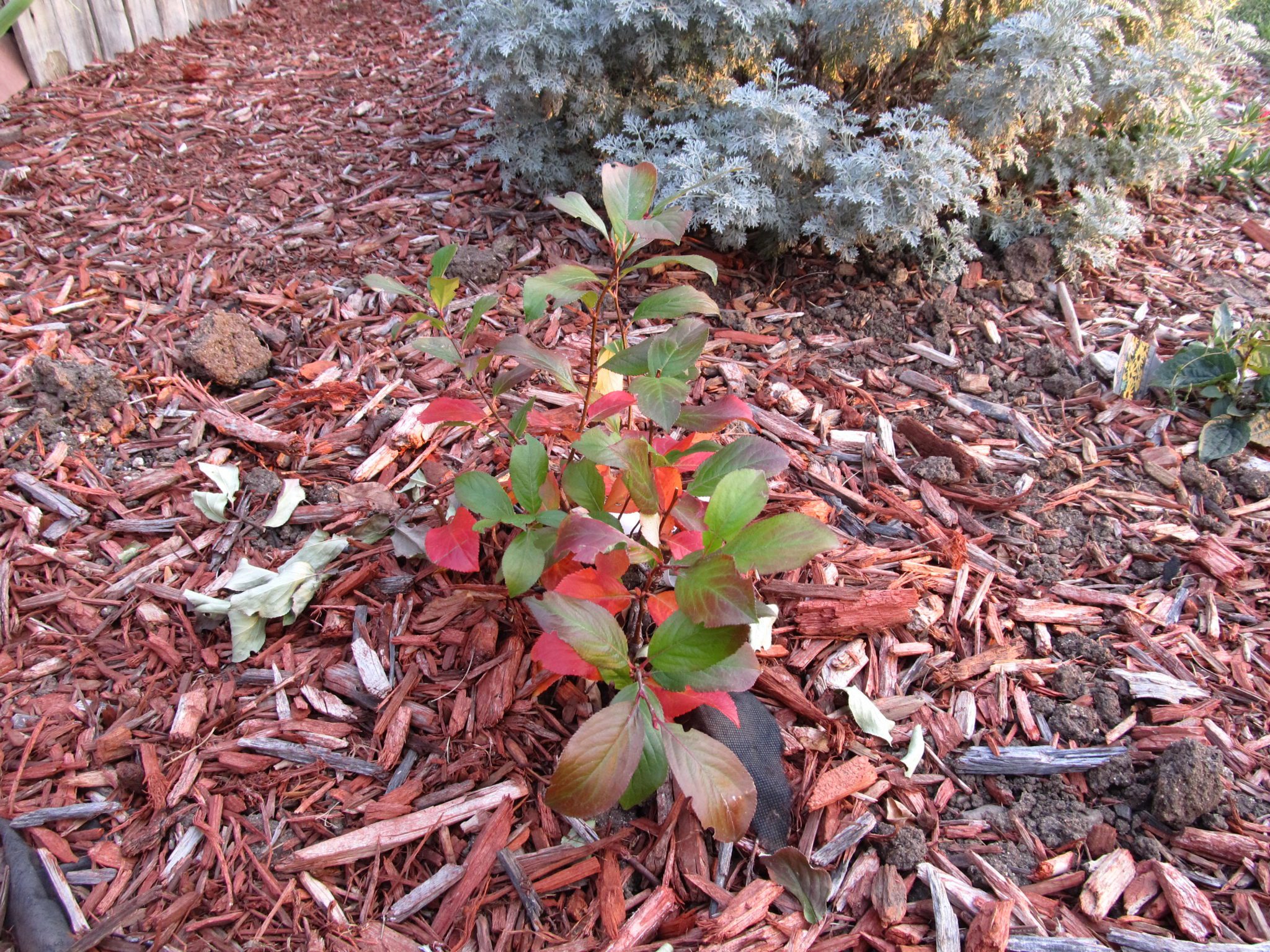
Below is a Blue Mist Spirea’s. While this spirea (which actually isn’t a spirea at all) is known more for its bright blue flowers that appear in late summer, its foliage also provides some yellow color in autumn. While I certainly wouldn’t call it intense, nevertheless, it is still a beautiful addition to the autumn border.
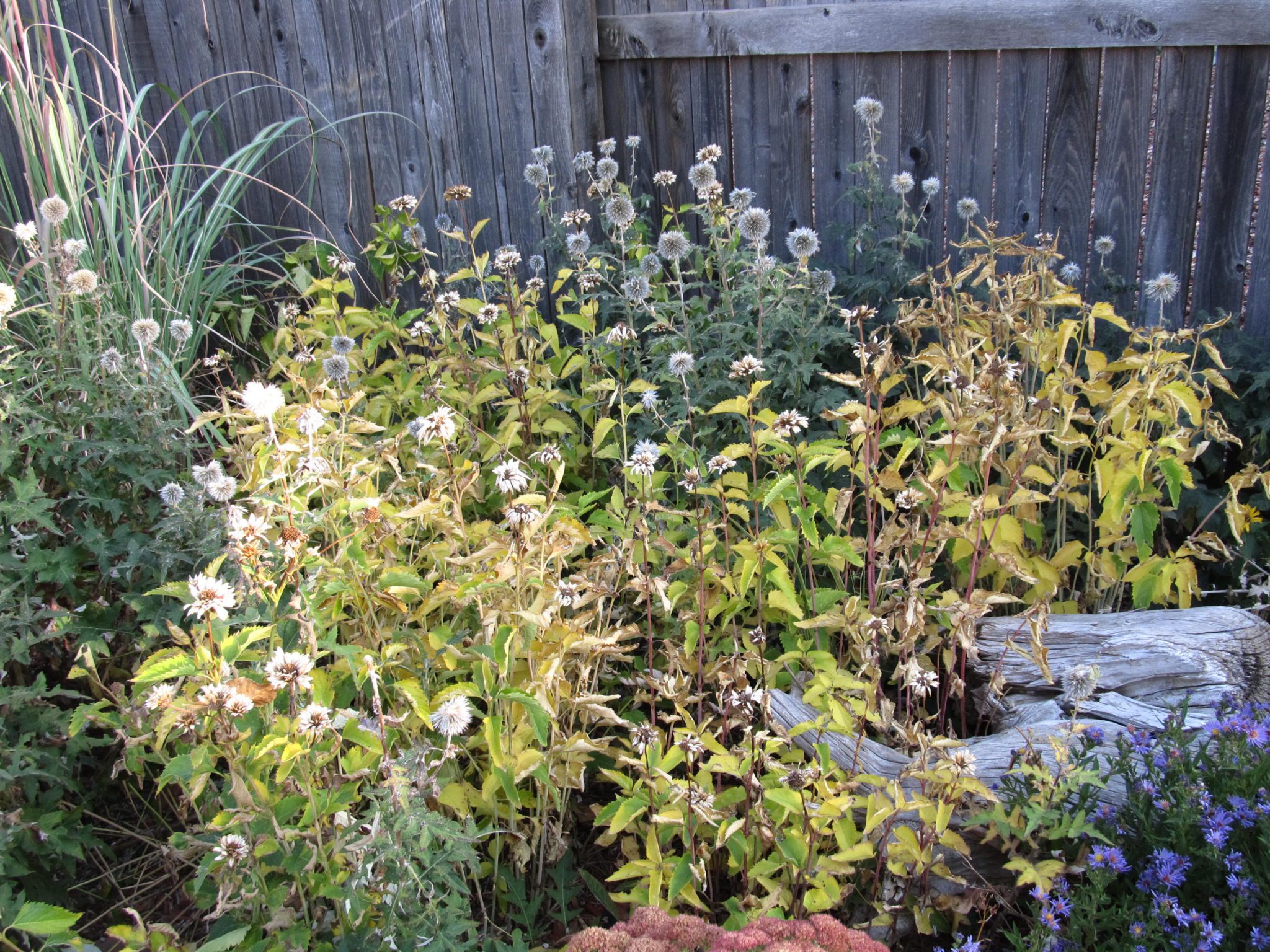
Ornamental grasses can also provide good autumn color. Below is ‘Shenandoah’ switchgrass mingling with sedums and a Blue Spruce.
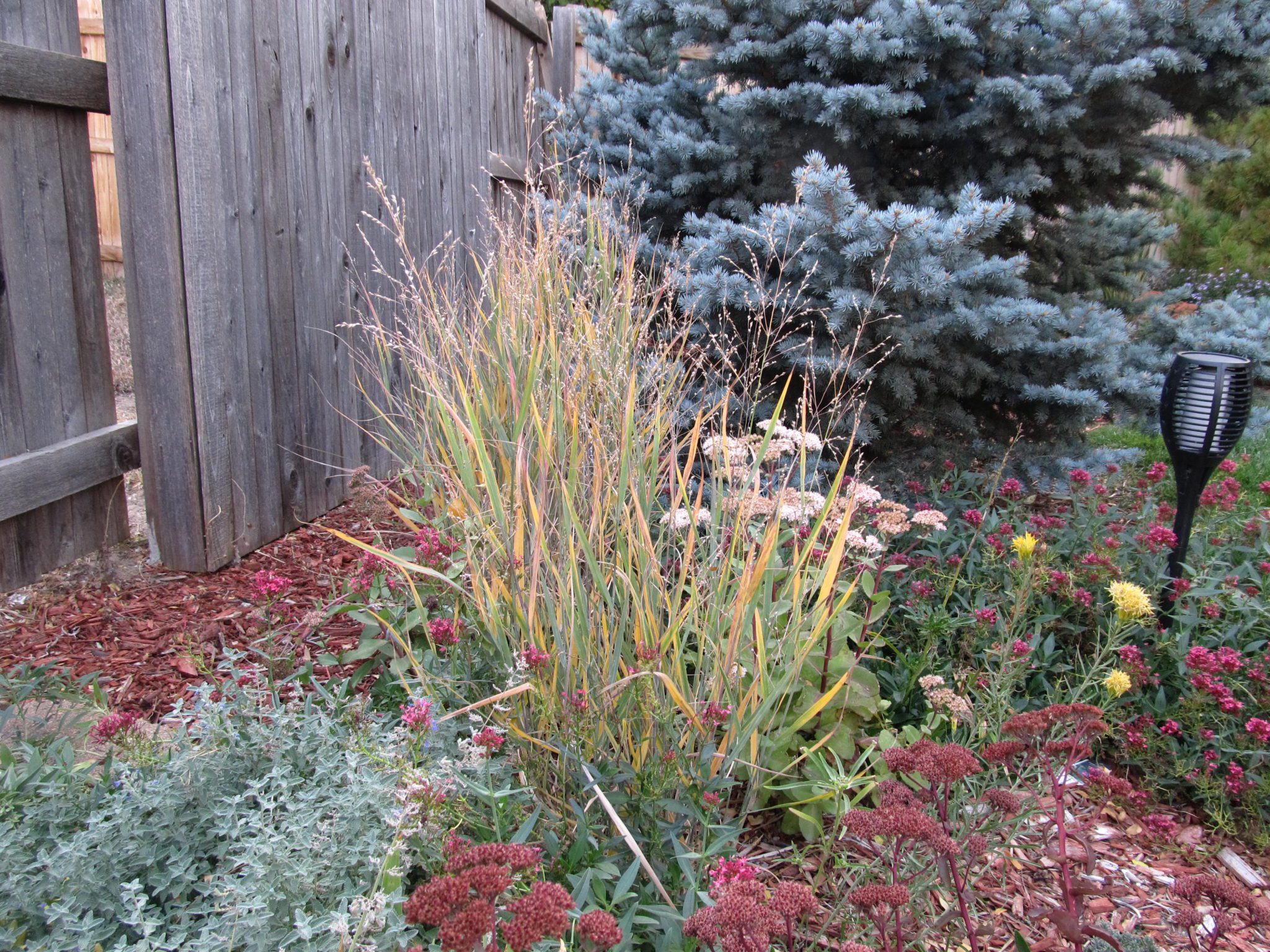
Below is a picture that will look familiar to you if you read part 2 of this series. I included it again because this time I want to focus on the colors of the changing foliage instead of the seed heads.
The giant miscanthus is only starting to change to its yellow-tan color, but the grass just to its left (I think it’s a different variety of switchgrass, but I’m really not sure) has turned to a muted orange color. Looks good together, don’t you think?
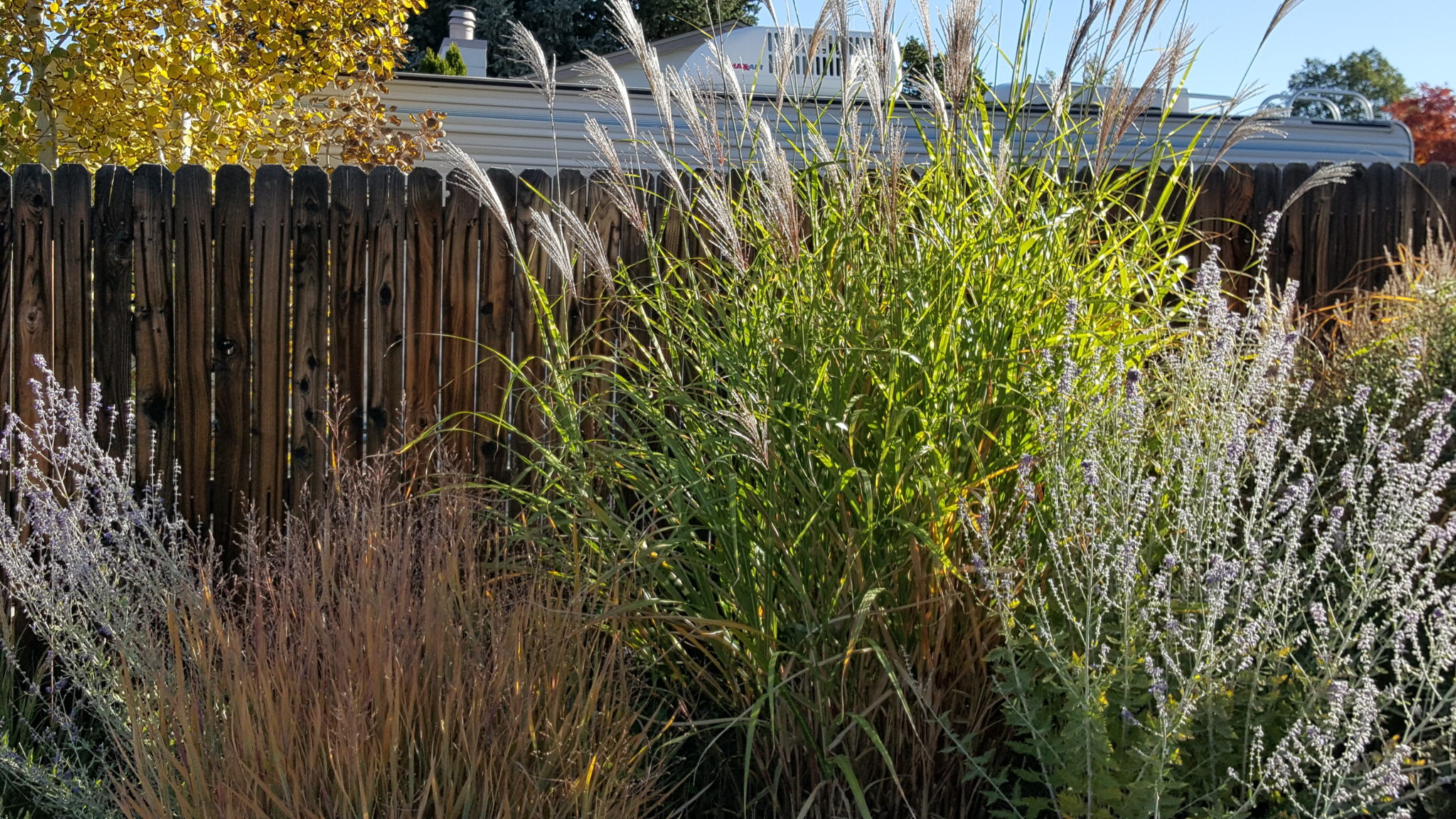
Perennials can sometimes provide autumn foliage as well. While they cannot possible compete with the enormous display put on by large trees and shrubs, they still can provide an understated addition to the seasonal fireworks.
Here we have the leaves of a plumbago turning a nice russet color in mid-autumn.
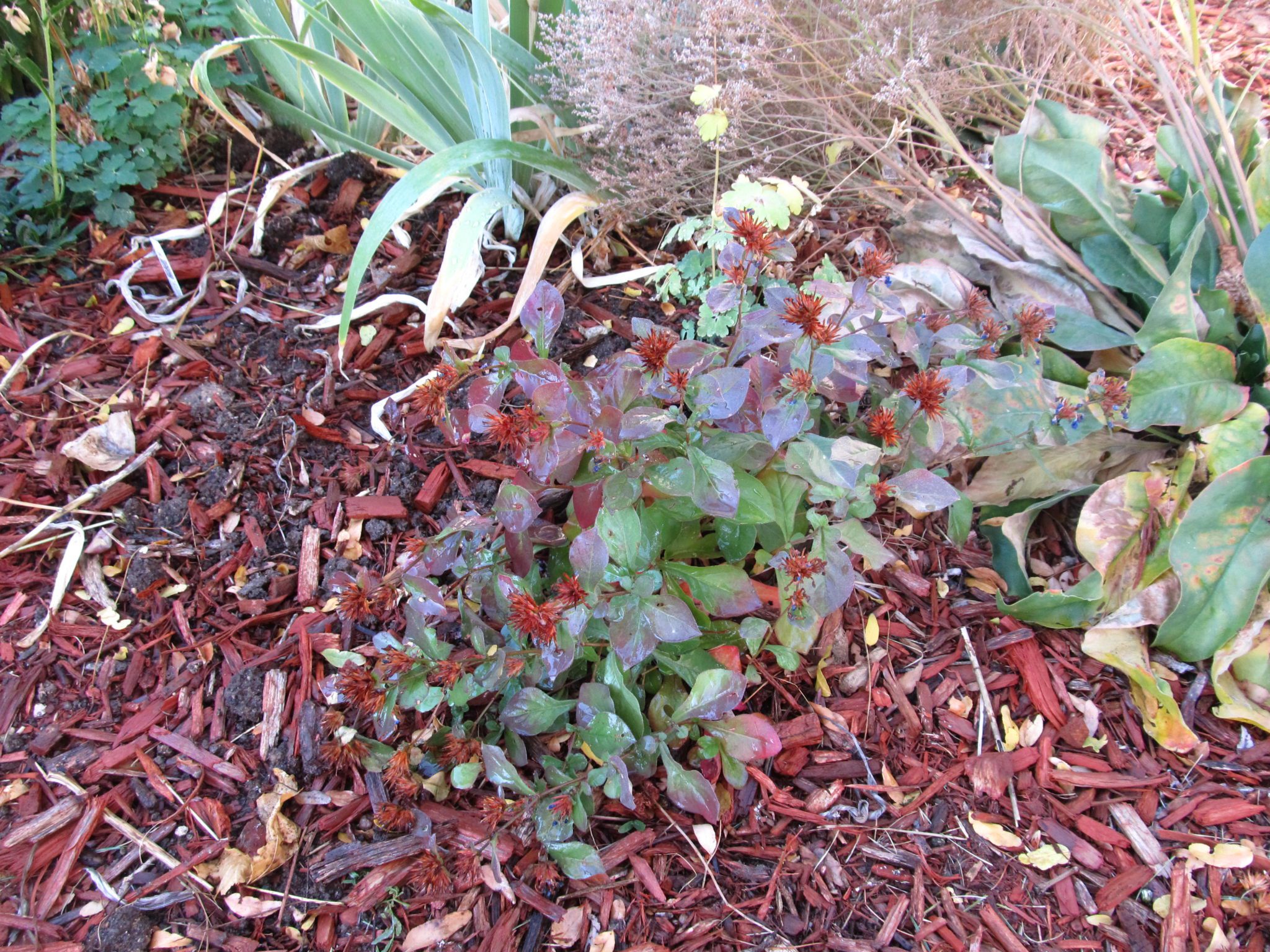
Even some Hostas can get into the act. These Hostas that I salvaged last year and put in a whiskey barrel are starting to turn to a buttery yellow color.
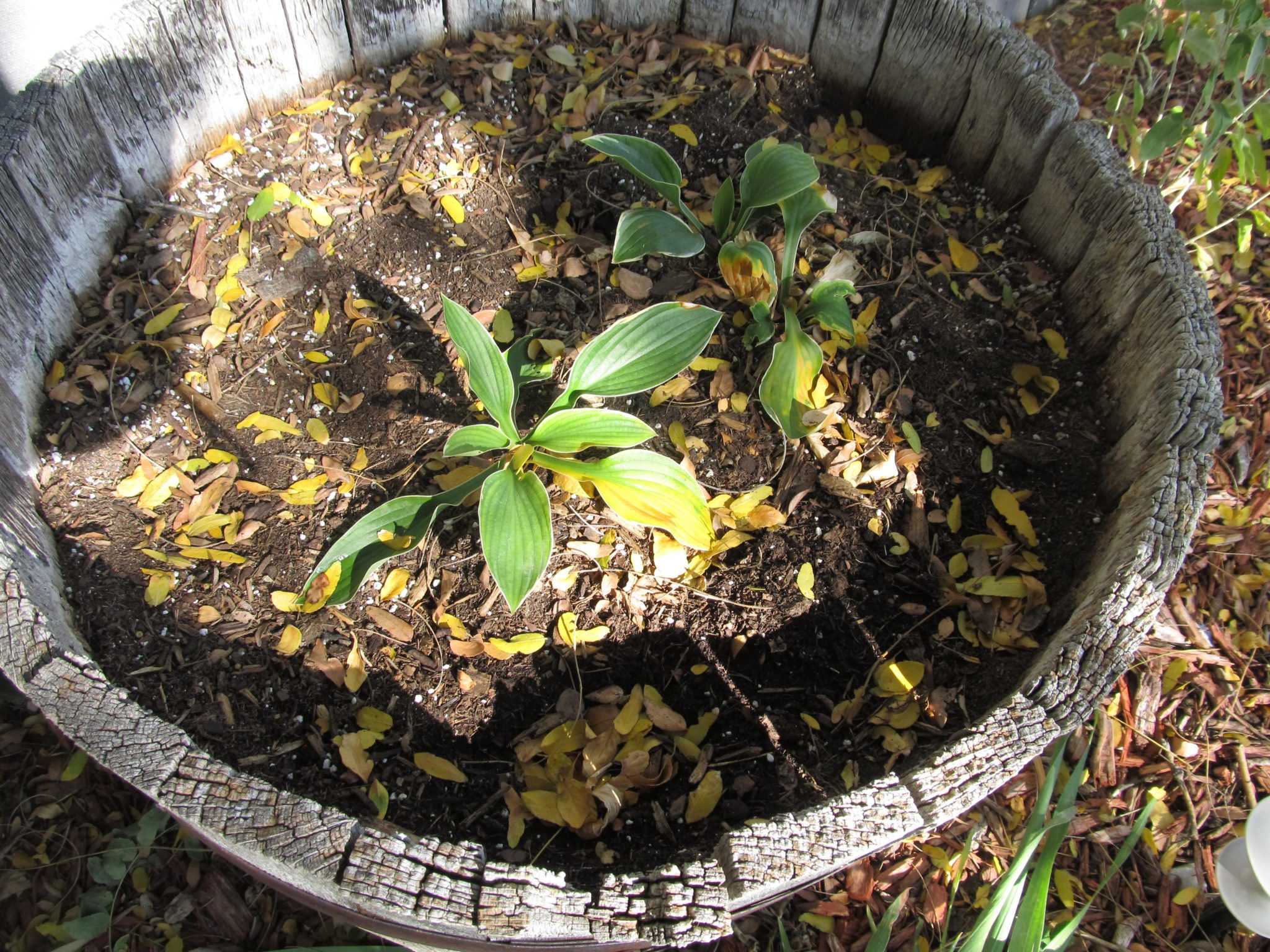
The Himalayan Fleeceflower, a tough and drought tolerant ground cover, turns a fiery red in autumn.
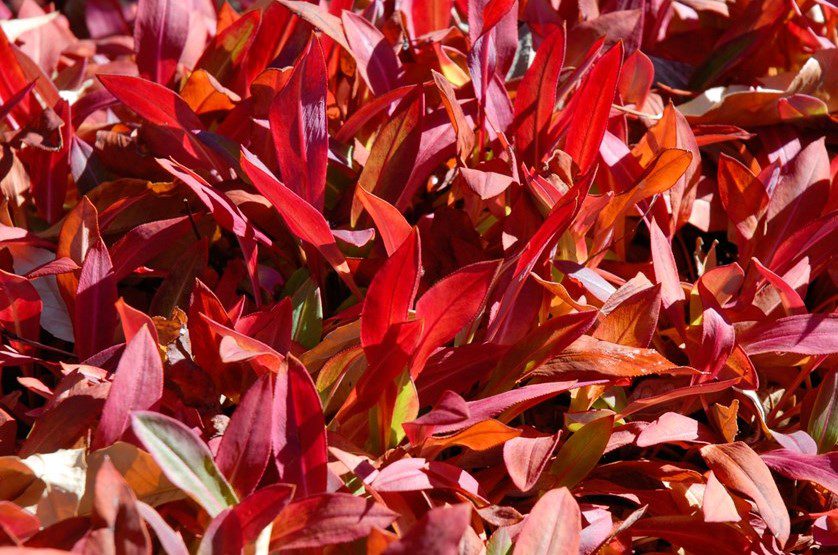
Finally:
Do not EVER plant this tree along the Front Range!
There is one tree that should NEVER be planted along the Front Range, and that is the aspen tree. For reasons lost to the mists of time, sometime in the 1980’s people decided to plant aspens down here on the lowlands. I strongly suspect that the tree’s famous fall color was the driving reason why.
Here’s the thing though: aspen trees do not thrive on the prairie. That is the domain of their cousins, the cottonwoods. It is far too hot and dry on the plains for aspens. Even in the mountains aspens predominantly colonize on the cooler and wetter northern and eastern slopes, rather than hotter and drier western and southern faces. Life on the western plains is, for all intents and purposes, one of the rings of hell for this poor tree.
Due to stress they are afflicted with diseases and insect damage, and so their lifespan here along the front range is usually less than 20 years. And while in some years their fall color can be decent, most years they just turn a muddy yellow. The temps start cooling off much earlier in the mountains, and it tends to get much colder at night than here on the plains, creating conditions conducive for their outstanding fall color. Down here in the lowlands, temperatures drop much later and the nights don’t start getting truly cold until almost the end of October, less than optimal conditions for good color.
There are better options.
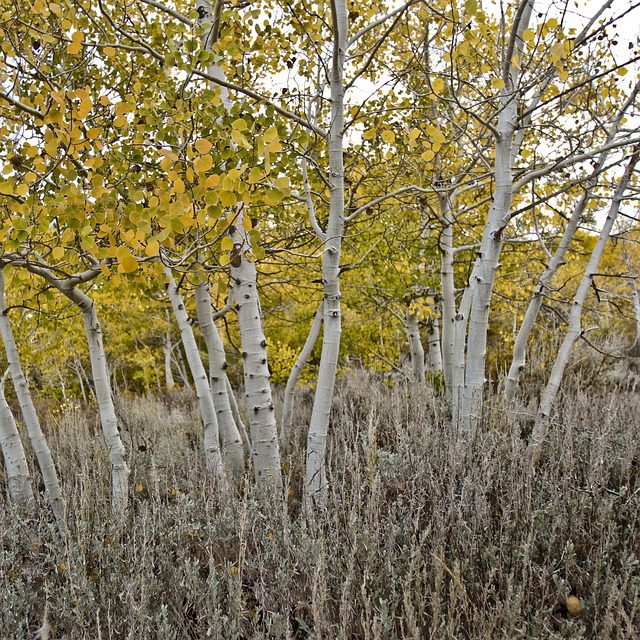
Conclusion
Planning for an autumn display in the garden takes a little bit of work, but it’s well worth it. It finishes of the season with a bang, and extends the growing season by several weeks.
One final suggestion: I would recommend clustering your fall blooming perennials together in one location rather than scattering them throughout the garden. This will ensure that your autumn display will stand out in all its glory.
What trees, shrubs or plants would you recommend for an outstanding autumn garden?

